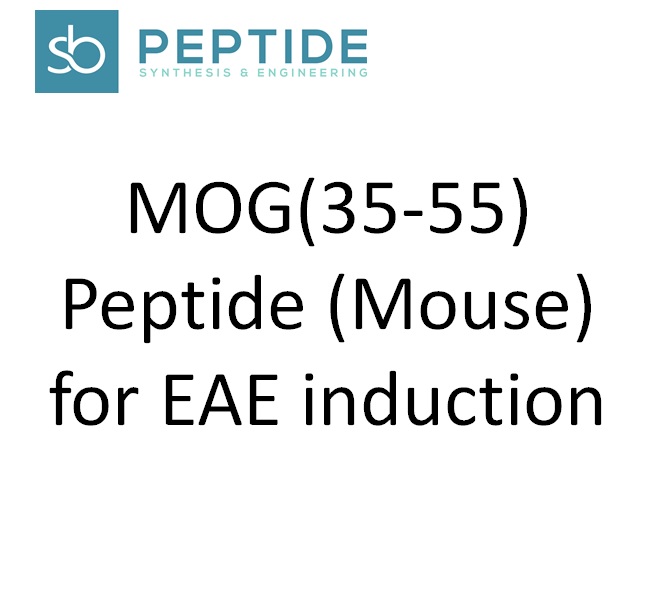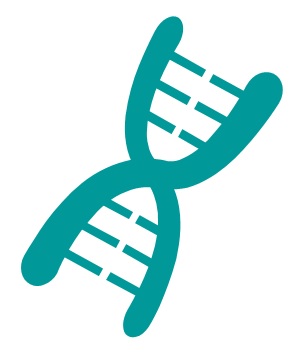MOG (35-55) peptide – Myelin Oligodendrocyte Glycoprotein peptide 35-55,Mouse
MOG35-55 – MEVGWYRSPFSRVVHLYRNGK – CAS 163913-87-9
Myelin oligodendrocyte glycoprotein (MOG) is a type I integral membrane glycoprotein of the immunoglobulin superfamily (Ig) found exclusively in mammals. The 26-28 kDa protein is located on the external surface of the oligodendrocyte membrane,mostly on the peripheral lamellae of myelin sheaths of the Central nervous system (CNS)1.
MOG35-55 for EAE induction
The immunodominant 35-55 epitope of MOG (MOG 35-55) is a primary target for both cellular and humoral immune responses1. Anti-MOG antibodies and the abnormal activation of encepalitogenic T cells upon recognition of MOG (35-55) peptide cause the destruction of myelin sheath during Multiple sclerosis (MS),a common inflammatory autoimmune disorder of the CNS1. Although MOG is a minor component of the CNS,the 35-55 epitope of MOG (MOG 35-55) is strongly immunogenic and therefore is widely used for in vivo biological evaluation and immunological studies of the Experimental Autoimmune Encephalomyelitis (EAE),a mouse animal model for T-cell-mediated inflammatory demyelinating autoimmune diseases of the CNS1.
Administration of MOG35-55 peptide in mice produces anti-MOG antibodies that cause demyelination and a chronic Experimental Autoimmune Encephalomyelitis1.
Anti-MOG antibodies are observed in cerebrospinal fluid (CFS) and the serum of MS pateints. There is a direct correlation between the severity of the MS symptomes and anti-MOG titers. The progression of Multiple sclerosis is rapid and relapses occur more frequently in presence of anti-MOG antibodies. Therefore,anti-MOG antibodies are an indicator for the prognosis and progression of Multiple sclerosis1. They can be detected by MOG (35-55) epitope-coated ELISA for quantification.
Check out the biotinylated version of MOG (35-55) peptide here
MOG (35-55)-induced EAE models can help elucidating the immunopathological mechanism of Multiple sclerosis and promote the developement of novel therapeutics. One therapeutic approach consists on the administration of a mixture of peptides,representing immunodominant epitopes of different myelin proteins including MOG peptide at a proper dose to modulate the immune response and induce tolerance1.
 Also available: Ready to use syringes with pre-emulsified MOG35-55/CFA EAE induction kit
Also available: Ready to use syringes with pre-emulsified MOG35-55/CFA EAE induction kit
 Click here to discover SB-PEPTIDE’s Human MOG peptides pool for T-cells activation
Click here to discover SB-PEPTIDE’s Human MOG peptides pool for T-cells activation
Technical specification
 |
Sequence : MEVGWYRSPFSRVVHLYRNGK |
 |
MW : 2 581.95 g/mol (C118H177N35O29S) |
 |
Purity : > 95% |
 |
Counter-Ion : TFA Salts (see option TFA removal) |
 |
Delivery format : Freeze dried in propylene 2mL microtubes |
 |
Other names : CAS 163913-87-9,AKOS030228368,KS-00000090 |
 |
Peptide Solubility Guideline |
 |
Bulk peptide quantities available |
Price
| Product catalog | Size | Price € HT | Price $ USD |
| SB023-1MG | 1 mg | 77 | 96 |
| SB023-5MG | 5 mg | 270 | 337 |
| SB023-2*5MG | 2×5 mg | 385 | 481 |
| SB023-5*10MG | 5×10 mg | 737 | 921 |
Quote request
If you are interested in ordering this product,please ask for a quote and we will get back to you shortly.
References
J. Neuro. Methods. 2022 Feb 01;367:109443. doi: https://doi.org/10.1016/j.jneumeth.2021.109443
An optimized and validated protocol for inducing chronic experimental autoimmune encephalomyelitis in C57BL/6J mice
Myelin oligodendrocyte glycoprotein induced experimental autoimmune encephalomyelitis (EAE) is the most commonly used animal model of multiple sclerosis. However, variations in the induction protocol can affect EAE progression, and may reduce the comparability of data.
J. Nature. 2021 Oct 31;24:84-95. doi: https://www.nature.com/articles/s41590-022-01374-0
ETV3 and ETV6 enable monocyte differentiation into dendritic cells by repressing macrophage fate commitment
In inflamed tissues, monocytes differentiate into macrophages (mo-Macs) or dendritic cells (mo-DCs). In chronic nonresolving inflammation, mo-DCs are major drivers of pathogenic events. Manipulating monocyte differentiation would therefore be an attractive therapeutic strategy. However, how the balance of mo-DC versus mo-Mac fate commitment is regulated is not clear. In the present study, we show that the transcriptional repressors ETV3 and ETV6 control human monocyte differentiation into mo-DCs. ETV3 and ETV6 inhibit interferon (IFN)-stimulated genes; however, their action on monocyte differentiation is independent of IFN signaling. Instead, we find that ETV3 and ETV6 directly repress mo-Mac development by controlling MAFB expression. Mice deficient for Etv6 in monocytes have spontaneous expression of IFN stimulated genes, confirming that Etv6 regulates IFN responses in vivo. Furthermore, these mice have impaired mo-DC differentiation during inflammation and reduced pathology in an experimental autoimmune encephalomyelitis model. These findings provide information about the molecular control of monocyte fate decision and identify ETV6 as a therapeutic target to redirect monocyte differentiation in inflammatory disorders.
J. Neuro. Methods. 2021 Mar 01;351:108999. doi: https://doi.org/10.1016/j.jneumeth.2020.108999
Titration of myelin oligodendrocyte glycoprotein (MOG) - Induced experimental autoimmune encephalomyelitis (EAE) model
Experimental autoimmune encephalomyelitis (EAE) induced by the myelin oligodendrocyte glycoprotein (MOG) peptide 35–55, is a widely used multiple sclerosis (MS) model. Unlike the spontaneous occurrence of MS, in EAE, external immunization with the MOG peptide (200−300 µg/mouse), emulsified in adjuvant enriched with Mycobacterium Tuberculosis (MT) H37Ra (100−500 µg mouse), and pertussis toxin (PTx, 200−500 ng/mouse) injections, are applied, which heavily boosts the immune system...
Eur. J. Immuno. 1995 July;25:1951-1959. doi: https://doi.org/10.1002/eji.1830250723
A myelin oligodendrocyte glycoprotein peptide induces typical chronic experimental autoimmune encephalomyelitis in H-2b mice: Fine specificity and T cell receptor Vβ expression of encephalitogenic T cells
A predominant response to myelin oligodendrocyte glycoprotein (MOG) was recently observed in patients with multiple sclerosis (MS). To study the possible pathogenic role of T cell response to MOG in MS, we have investigated the encephalitogenic potential of MOG. Synthetic MOG peptides, pMOG 1-21, 35–55, 67–87, 104–117 and 202–218, representing predicted T cell epitopes, were injected into C57BL/6J and C3H.SW (H-2b) mice.
